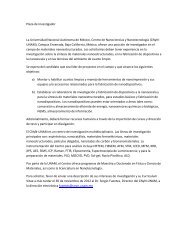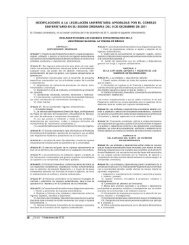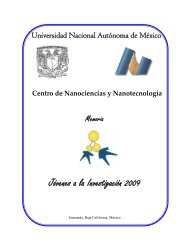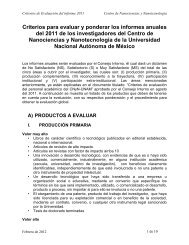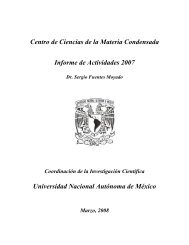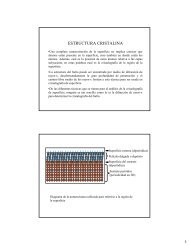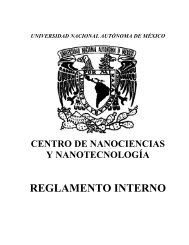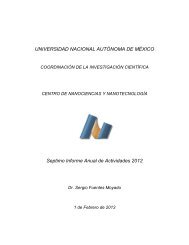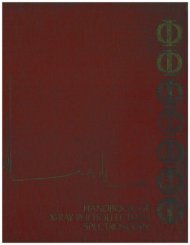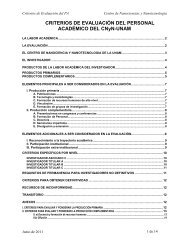Universidad Nacional Autónoma de México - CNyN
Universidad Nacional Autónoma de México - CNyN
Universidad Nacional Autónoma de México - CNyN
Create successful ePaper yourself
Turn your PDF publications into a flip-book with our unique Google optimized e-Paper software.
1st International Symposium on Nanoscience and Nanomaterials<br />
occurs around 400 K, as the copper atoms become reduced to a metallic state, to form acetonitrile and a secbutylamido<br />
surface species that reacts further at 485 K to release 2-butene, and by 800 K, only copper and a<br />
small amount of carbon can be seen on the surface by XPS. A temperature window between approximately<br />
350 and 450 K was i<strong>de</strong>ntified for the clean <strong>de</strong>position of the precursor on the surface: lower temperatures are<br />
insufficient for activation of the dissociative adsorption, and higher temperatures lead to continuous<br />
<strong>de</strong>composition beyond Cu monolayer saturation.<br />
PLENARY III<br />
SYNTHESIS AND PROPERTIES OF SMALL DIMENSIONAL STRUCTURES OF TRANSPARENT<br />
CONDUCTING OXIDES.<br />
Ana Crema<strong>de</strong>s 1,a , D. Maestre 1,b , Javier Bartolomé 1,c , Cristian Vásquez 1,d , Manuel Herrera 2,e and J. Piqueras 1,f .<br />
1 Departamento <strong>de</strong> Física <strong>de</strong> Materiales, Facultad <strong>de</strong> Físicas, <strong>Universidad</strong> Complutense <strong>de</strong> Madrid, 28040<br />
Madrid, Spain<br />
2 Centro <strong>de</strong> Nanociencias y Nanotecnología, <strong>Universidad</strong> <strong>Nacional</strong> Autónoma <strong>de</strong> México, Ensenada, México<br />
a crema<strong>de</strong>s@fis.ucm.es, b davidmaestre@fis.ucm.es , c j.bartolome@fis.ucm.es, d gc.vasquezv@pas.ucm.es, e<br />
zaldivar@cnyn.unam.mx , f piqueras@fis.ucm.es<br />
Keywords: TCO Nanostructures, Vapor-solid growth, Doping, Luminescence<br />
Indium, tin and titanium oxi<strong>de</strong>s are extensively investigated transparent conducting oxi<strong>de</strong> materials<br />
with relevant technological applications in many fields, such as optoelectronic <strong>de</strong>vices, solar cells, field<br />
emitters, or gas sensors. Recently, the synthesis and characterization of undoped and doped nano- and<br />
microstructures of these materials in forms of nanowires, nanorods, nanopyramids, or nanoarrows have<br />
attracted increasing attention, as the exploitation of the phenomena appearing at the nanoscale could spread<br />
their applications as nanoelectronic and optoelectronic <strong>de</strong>vices. However, although a reasonable control of the<br />
growth of nanostructures has been achieved, some relevant issues related to the growth mechanism are still<br />
open. Anisotropic growth, <strong>de</strong>fect-induced growth, self catalytic growth, and oxi<strong>de</strong> assisted growth have been<br />
suggested to be the driven forces of nanowire growth by the VS process. Recently, a dislocation driven<br />
growth mechanism has been proposed for indium oxi<strong>de</strong>, indium tin oxi<strong>de</strong> (ITO) nanostructures 1,2 and zinc<br />
doped indium oxi<strong>de</strong> 3 . Effective or limited doping incorporation is another aspect directly related to the control<br />
of properties of interest for applications as luminescence, gui<strong>de</strong> lighting behavior, and field emission. Besi<strong>de</strong>,<br />
the adsorption of doping atoms to the surfaces of the growing nanostructures may cause inhibition of the<br />
crystalline growth as observed for Mn doped In 2 O 3 4 or SnO 2 5 , or even phase transformation of the host lattice 6<br />
as for V doped TiO 2 ,or ternary formation 3 as for Zn doped In 2 O 3 or Er doped SnO 2 . This contribution<br />
elucidates some of the former aspects for doped In 2 O 3 , SnO 2 and TiO 2 micro- and nanostructures grown by an<br />
evaporation-solidification method. The relationship between their structure and the electronic and optical<br />
properties as a function of the doping, with elements such as rare earths, transition metals, Sn or Zn, has been<br />
investigated. The structure has been characterized by SEM and TEM and the chemical analysis have been<br />
performed by means of energy dispersive spectroscopy and X-ray photoelectron spectroscopy. Imaging and<br />
spectral cathodoluminescence have been used for the luminescence analysis.<br />
1D . Maestre et al. Crystal growth and <strong>de</strong>sign 11, 1117 – 1121 (2011)<br />
2D . Maestre et al. J. Phys. Chem. C 115, 18083-18087, (2011)<br />
3J . Bartolomé et al. J.Phys.Chem.C 115, 8354-8360, (2011)<br />
2




